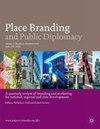From Gagarin to Sputnik: the role of nostalgia in Russian public diplomacy
IF 1.9
Q3 HOSPITALITY, LEISURE, SPORT & TOURISM
引用次数: 4
Abstract
In recent years, diplomats have increasingly employed nostalgic tropes in their digital communications (Surowiec and Manor 2020). As a public diplomacy instrument, nostalgia serves two ends. First, nostalgia can be used to help digital public makes sense of complex crises using historical precedent. Second, nostalgia can be used to reduce feelings of uncertainty brought about by globalization and the contestation of local traditions as well as novel planetary threats. By summoning a nation’s past to the present, the past becomes a template that illuminates the present and elucidates the future (Miskimmon et al. 2014). For instance, British officials have equated Brexit with the British Empire’s ‘last stand’ during WWII in which an independent UK charted its own destiny (Saunders 2020). Over the past 2 years, the Russian MFA has promoted three nostalgic campaigns on Twitter. The first, called ‘Faces of Victory,’ celebrates the heroes of the Red Army. The second commemorates important Red Army victories in WWII. Notably, in these tweets, the Red Army is re-imagined as a diverse people’s army, a fighting force that represented the diversity of the USSR as its soldiers belonged to different religions, nationalities, and ethnicities. Concurrently, the Russian MFA has used Twitter to lambast Baltic States for re-writing history by ignoring the Red Army’s role in the defeat of Nazi Germany (Manor 2019) (Fig. 1). The third campaign commemorates the flight of Cosmonaut Yuri Gagarin. On Twitter, the MFA re-imagined the Space Race not as a global competition over hegemony, but as an endeavor that advanced all of humanity. The MFA used images from Gagarin’s personal life, as well as images from monuments to Gagarin’s flight across the world to transform the Cosmonaut from as a Russian hero to a global one. In this campaign, Russia celebrated the scientific achievements of the USSR while arguing that the USSR, and the bi-polar system, did not undermine global peace but actually benefitted all of mankind through scientific and technological advancements.1 Notably, the Russian MFA’s use of nostalgic tropes can be viewed as part of a wider effort to disseminate revisionist narratives that re-interpret history, with an emphasis on WWII. In this way, Russia’s use of nostalgic tropes differs from other states’ use of nostalgia to narrate complex crisis or reduce feelings of uncertainty following geo-political shifts (e.g., Brexit). Russia’s historic revisionism is, in part, a response to a 2019 European Parliament resolution that condemned Russia for colluding with Nazi Germany and starting WWII. The resolution also called for the removal of Soviet war memorials across Europe (Radchenko 2020). Notably, Russia’s historic revisionism, and reliance of nostalgic tropes, may be but a tool to rally domestic support in Putin, while diverting attention from Russia’s domestic woes (Sargeant 2021). For example, in a 2020 meeting of world leaders Putin discussed WWII at length, arguing that the war was the result of Poland’s collusion with Nazi Germany (Radchenko 2020). Taken within this revisionist context, the Russian MFA’s re-imagining of the Red Army and the Space Race is but one element in a larger effort in which a tangled web of official and non-official digital channels promote a a meta-narrative built on a dichotomy of “Russia as an ally with a common history, culture and interests” and the “West as a foreign, imperialist enemy” (Ukraine, Crisis Media Center 2020). We contend that nostalgia also underpins Russia’s attempts to market its Covid19 vaccine on Twitter. The vaccine’s very name, Sputnik, harks back to the USSR and the Space Race. The name suggests that the same minds * James Pamment James.pamment@isk.lu.se从加加林到人造卫星:怀旧在俄罗斯公共外交中的作用
近年来,外交官们在数字通信中越来越多地使用怀旧的比喻(Surowiec和Manor 2020)。作为一种公共外交工具,怀旧有两个目的。首先,怀旧可以用来帮助数字公众利用历史先例理解复杂的危机。其次,怀旧可以用来减少全球化和地方传统的争夺以及新的地球威胁所带来的不确定感。通过将一个国家的过去召唤到现在,过去成为照亮现在和阐明未来的模板(Miskimmon et al. 2014)。例如,英国官员将脱欧与大英帝国在二战期间的“最后一战”等同起来,在这场战争中,独立的英国决定了自己的命运(Saunders 2020)。在过去的两年里,俄罗斯外交部在推特上发起了三次怀旧活动。第一幅名为“胜利的面孔”,歌颂红军的英雄们。第二个纪念红军在二战中的重要胜利。值得注意的是,在这些推文中,红军被重新想象成一支多元化的人民军队,一支代表苏联多样性的战斗力量,因为它的士兵属于不同的宗教、民族和种族。与此同时,俄罗斯外交部利用推特抨击波罗的海国家无视红军在击败纳粹德国中的作用,改写了历史(《庄园》2019)(图1)。第三场战役是为了纪念宇航员尤里·加加林的飞行。在推特上,外交部重新把太空竞赛想象成一场推动全人类进步的努力,而不是一场争夺霸权的全球竞争。俄罗斯外交部使用了加加林个人生活中的照片,以及纪念加加林环球飞行的纪念碑上的照片,将这位宇航员从俄罗斯英雄转变为全球英雄。在这场运动中,俄罗斯庆祝苏联的科学成就,同时认为苏联和两极制度并没有破坏全球和平,而是通过科学和技术进步使全人类受益值得注意的是,俄罗斯外交部使用怀旧的比喻可以被视为传播修正主义叙事,重新解释历史的更广泛努力的一部分,重点是第二次世界大战。因此,俄罗斯对怀旧比喻的使用不同于其他国家使用怀旧来叙述复杂的危机或减少地缘政治变化(如英国脱欧)后的不确定感。俄罗斯的历史修正主义在一定程度上是对2019年欧洲议会一项决议的回应,该决议谴责俄罗斯与纳粹德国勾结,发动了第二次世界大战。该决议还呼吁在欧洲各地拆除苏联战争纪念碑(Radchenko 2020)。值得注意的是,俄罗斯的历史修正主义和对怀旧比喻的依赖,可能只是普京争取国内支持的一种工具,同时转移人们对俄罗斯国内困境的注意力(Sargeant 2021)。例如,在2020年的世界领导人会议上,普京详细讨论了第二次世界大战,认为这场战争是波兰与纳粹德国勾结的结果(Radchenko 2020)。在这种修正主义背景下,俄罗斯外交部对红军和太空竞赛的重新想象只是一个更大努力中的一个因素,在这个更大努力中,官方和非官方数字渠道的错综复杂的网络促进了一种建立在“俄罗斯作为具有共同历史、文化和利益的盟友”和“西方作为外国帝国主义敌人”二元对立基础上的元叙事(乌克兰,危机媒体中心2020)。我们认为,怀旧情绪也是俄罗斯试图在推特上推销其covid - 19疫苗的基础。这种疫苗的名字Sputnik让人想起了苏联和太空竞赛。这个名字暗示着同样的思想*詹姆斯·帕门特James.pamment@isk.lu.se
本文章由计算机程序翻译,如有差异,请以英文原文为准。
求助全文
约1分钟内获得全文
求助全文
来源期刊
CiteScore
3.80
自引率
13.30%
发文量
30
期刊介绍:
Place Branding and Public Diplomacy?is a pioneering journal and the first to concentrate on this fast-growing field. Its scope and reach is global and culturally unbiased. Its primary objective is to broaden the understanding of the nature purposes and benefits of both place branding and public diplomacy and to demonstrate how place branding and public diplomacy strategies are implemented in practice.Place branding is the practice of applying brand strategy and other techniques and disciplines - some deriving from commercial practice others newly developed - to the economic social political and cultural development of cities regions and countries. Public diplomacy is the process by which an international actor – often but not exclusively a country – conducts foreign policy by engaging a foreign public. Public Diplomacy and Place Branding are not synonyms but their overlaps are sufficient to justify a journal which considers both activities in their own right and at their point of convergence.Both Place Branding and Public Diplomacy are significantly but not exclusively concerned with reputation management.

 求助内容:
求助内容: 应助结果提醒方式:
应助结果提醒方式:


